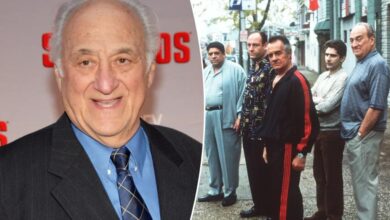Phil Falcone, hedge-fund billionaire fallen on tough times, reveals which of his assets hurt the most to sell

There has been no soft landing for the formerly high-flying Phil Falcone.
Once a hedge-fund superstar worth $2 billion, bad investments have left him having to sell off his prized possessions to pay his bills: Upper East Side townhouses, a Hamptons mansion, a custom made grand piano, all gone.
🎬 Get Free Netflix Logins
Claim your free working Netflix accounts for streaming in HD! Limited slots available for active users only.
- No subscription required
- Works on mobile, PC & smart TV
- Updated login details daily
Now he is in a legal tussle with a pawnbroker over millions of dollars of goods he and movie producer wife Lisa Maria Falcone put up as collateral, according to court records. It’s a long fall from grace from making a name as philanthropists and hosting movie stars.
But Falcone, who hauled in most of his cash betting huge against sub-prime mortgages like in movie “The Big Short,” remains optimistic about a comeback, even as others wager against him.
But first, he has to get his wife’s ring back. The pink-colored 20.45-carat diamond ring came from the elite jeweler Harry Winston and Falcone claims it is worth $6.3 million. It was one of the items pawned.
“I was prepared to buy the ring back. They sold the ring before the note was due,” the blustery Falcone claimed to The Post.
Told that the ring was sold at a foreclosure auction, Falcone claims it was a likely a set up.
“They probably sold it to one of their friends for pennies,” he added. The pawn company maintains he didn’t buy it back in time.
It’s quite a comedown for the cofounder of Harbinger Capital, which managed $26 billion at its peak.
The company’s undoing came amid SEC allegations Falcone improperly used $113 million of investor funds to pay his personal taxes. He denied this to The Post and said the money came from his own capital account.
At any rate, it resulted in an $18 million settlement and Falcone being barred from the securities industry for at least five years.
The investigation was also a harbinger of worse to come. An all-in investment ended badly, contributing to the company’s decimation and leaving Falcone to pawn some of his precious artworks to secure a loan for $92.5 million back in 2013.
Rarefied pieces including Richard Prince’s “Untitled (Cowboy),” Pablo Picasso’s “Deux Nus” and Damien Hirst’s “I love you, love buds” and “A Playful Bubblegum Kiss” were all used as guarantees.
Just one problem: It’s alleged in court papers the artwork was pledged for two different loans to two different lenders.
That’s led to a still-unresolved legal tangle between Falcone and lender BLCE. A judge ruled he should have known he couldn’t put the same asset up two different lenders, Falcone and his lawyer are appealing, contending the value of the art could have been shared by the two parties.
“These guys are professional lenders,” Falcone told The Post. “They entered into this with eyes wide open.”
Falcone insisted he is “not losing sleep over the ring and the art,” but it is the latest chapter in what appears to be an embarrassing third act in an up-from-nothing story that now includes the public liquidation of Falcone and his wife Lisa Maria’s valuable assets.
Last year, the Falcones sold a Sagaponack beachfront mansion for $14 million in an all-cash transaction. Their place in St. Barths went for $57 million. In 2019, he scored $77 million on the sale of a townhouse on 14-16 East 67th Street. Once the home of Bob Guccione, it benefited from a $10 million renovation carried out by the Falcones.
The luxe digs sported a dry-cleaning setup in the basement, a bar in one of Lisa’s walk-in closets and a heated sidewalk to keep snow from accumulating, possibly the best revenge for a guy who grew up in the frigid climes of Minnesota. At the time, it was the highest priced residential sale in New York City history.
Another Upper East Side townhouse of the Falcones went for $27 million, and all the furniture in the place was sold in what The Post dubbed “a fire sale.”
Among the top accoutrements: a custom white lacquer Steinway grand piano with a sterling silver frame (bought for $180,000 and sold for $50,000), a neoclassical artwork by Merry-Joseph Blondel and his partner Joseph Dufour went for $7,500 after being listed at $23,500 and a leather sofa (just $3,750).
In 2022, when he was called out for unloading the stuff, Falcone referenced an upcoming trial from which he hoped for a 10-figure settlement. “It’s a $5 billion lawsuit,” he told a Post reporter. “Do you think that’s worth nothing?”
Now he says, “It’s my money and these things are mine to sell.”
Other complaining creditors over the years have included a limousine company (the Wall Street Journal reported that he owed $34,000), a landlord and the law-firm that represented him in the SEC case, who all accuse Falcone of owing them money.
In 2021, the Journal reported that his one-time attorney won a $14 million judgment against him. In 2021, the attorney said Falcone has made “modest payments … as a result of our endlessly chasing him.”
Upon hearing this, Falcone said, “I’m still dealing with the lawyer, but the others have been settled. It’s been a rollercoaster.”
Once famous for owning a pot-bellied pig named Wilbur, hanging out with Alicia Keys and her husband Swizz Beatz and swanning it up at big-ticket fundraisers, Falcone and his wife hosted lavish parties where Madonna and Edward Norton would regularly attend.
Fast forward to a 2020 court appearance and Falcone was representing himself, claiming to be unable to afford a lawyer. He told the judge, “I’m behind on virtually every one of my bills. Including my kids’ tuition.”
When asked if he’s broke, Falcone shrugged it off and told The Post, “There’s a difference between liquidity and illiquidity.”
Still, headlines like “How to lose $2 billion in 10 years” do him no favors.
However, to lose $2 billion, you need to make it first. On his path to success, Philip Falcone lived the great story of the brainy New York arriviste.
Fresh out of Harvard and one season as a professional hockey player in Sweden, in 1985, he landed his first Wall Street job: trading junk bonds and earning $20,000 per year. In 1992, he met Lisa Marie Velasquez, a model. They fell in love, married in ‘97 and once shared a studio apartment with an air mattress on the floor.
Then he hit big with the his hedge fund, and hit it even bigger with the prescient and ongoing $15 billion wager that subprime mortgages would collapse.
When the sub-primes went to hell, he made money and made headlines. Lisa Marie became a big booster of the Metropolitan Opera and at an event for Friends of the High Line, she announced an apparently spontaneous $10 million donation.
Lisa Maria got involved in producing movies and bragged to W about “not making any money” from the productions. “Zero … Everyone knows I don’t have to work,”
Some of the movies, including “Mud” with Matthew McConaughey and the bio-drama “127 Hours,” starring James Franco, were profitable. Falcone, meanwhile, purchased the Minnesota Wild, an NHL team. That’s since gone the way of the fancy houses.
“That’s one thing I probably should have held onto,” he said with remorse. “When I sold it, it had a $300 million valuation. Now they’re saying it’s worth $1.6 billion. It was part of my selling assets to pay down debt. But, you know, it doesn’t mean I can’t do it again.”
Still, he remains upbeat and warns he may appear down, but he’s not out.
“People say I’ve fallen on hard times. I don’t even know what the hell that means. It’s not like I am having chemotherapy for God’s sake.
“I’m happy and thriving. I came from nothing. I lost a little bit of money. People say I am sitting on death’s door and I’m not. Not even close.”
Credit to Nypost AND Peoples



